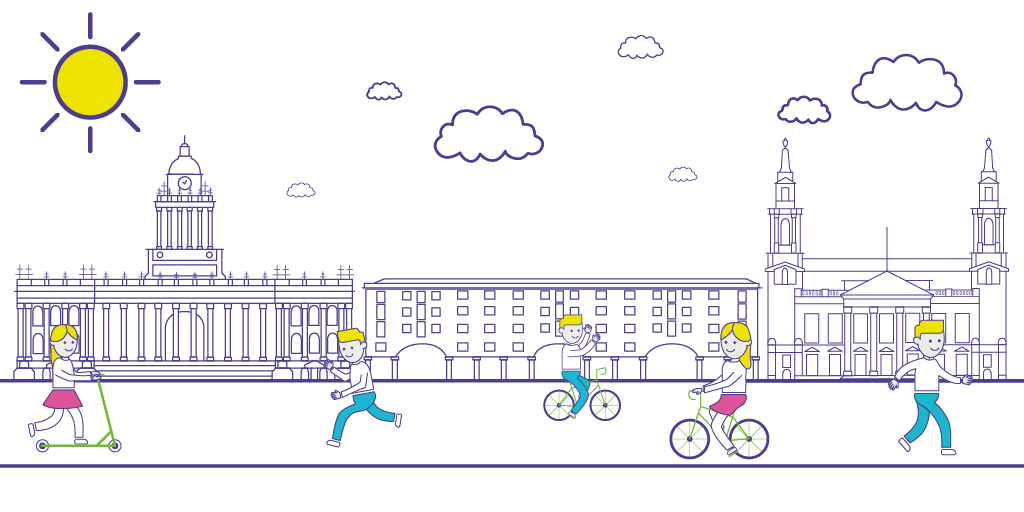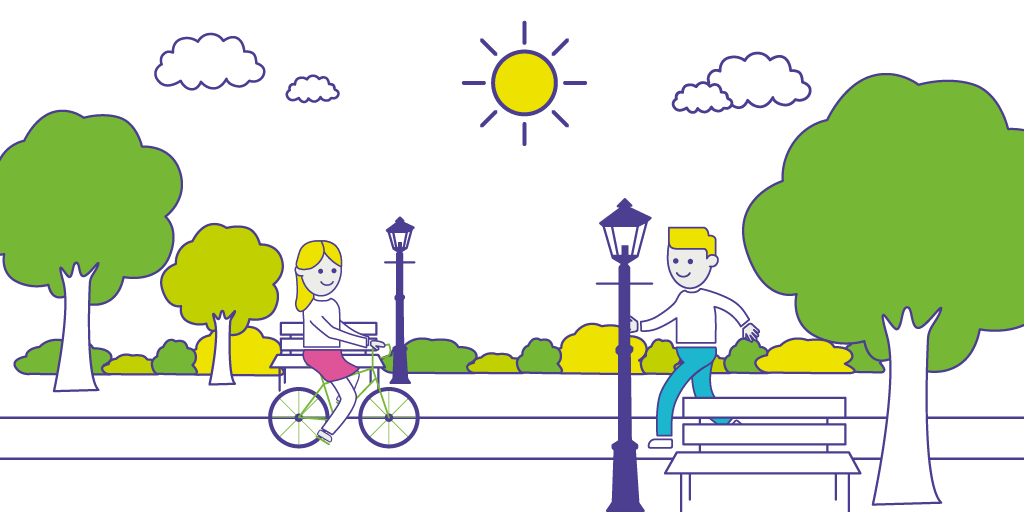Active travel – making journeys by physically active means such as walking, cycling or scooting – is key in improving the country’s health and wellbeing.
As we all deal with the unprecedented challenges of Covid-19, it brings to the forefront of our minds, the importance of finding ways to stay active and change the way we go about our daily lives.
In our 2020/21 Business Plan, Transport for the North Chief Executive Barry White says the Coronavirus pandemic is more than a health crisis, adding it will have wide-reaching and long-lasting effects on our economies, our wellbeing, and our environment.
He sets out how roads must be a sustainable part of our way of travelling for generations to come, by actively providing for public transport and active travel.
Although we all should be making only essential journeys at this time, we can still consider how we all will make changes when we begin to emerge from the crisis.
The Government and rail operators are right now urging people to avoid Public Transport where possible, and look to active travel, such as cycling and walking, as the main way to commute.
So for shorter commutes, walking to and from work helps keep the rail and bus network safer for those who need it, and for those staff working there. It is also a great way to get some steps in but also to save on transport fees.
If journeys are longer, travelling actively to and from a train station or bus stops for those essential journeys also presents plenty of health and environmental benefits.
Investment in infrastructure for active travel is an important part of our Major Roads Network, as this will enable and encourage passengers to adopt new behaviours and switch their journeys.
Across the North West, Yorkshire and the Humber, and the North East, the north of England is creating more opportunities for physical activity by investing in active travel options. Below, we highlight a few of these initiatives and the great work already being done in the North.

In the diverse North West, active travel commissioners, private entities and networking groups all play an important part in promoting active travel in the region.
In September 2019, Chair of the Liverpool City Region combined Authority Transport Committee, Liam Robinson, backed plans to invest £172 million in public and sustainable transport to drive inclusive growth across the city region. This included increasing public transport networks, making it more attractive and easier for people to get around on foot or by bike. It is also supported by improving health and wellbeing, which is at the top of the agenda.
Cycling champion Simon O’Brien, who is also an active travel commissioner for the Liverpool City Council, is supporting the £500 million upgrade to the city’s highways network, piloting green corridors through the URBAN GreenUP project. This scheme is improving access for all road users, especially cyclists, with plans including connecting the city’s southern and northern shorelines to create a 30-mile riverside route.
Mr O’Brien works alongside the council’s walking, cycling and greenspace officers, which is seen as a key part of the city’s Clean Air and Fitness strategies to reduce pollution and improve health and wellbeing rates.
In urban areas, private entities such as Arrivaclick allow multiple passengers who are all heading in the same direction to book a flexible minibus service, incentivising people to walk, cycle or run to meet at a pinned location.
The North West Active Travel Network also plays a great part in helping to establish working relationships between the Government, local authorities, and advocates, and frequently hold events and seminars to discuss infrastructure and benefits of active travel.

This region, rich in contemporary culture, historical attractions, World Heritage Sites and dramatic landscapes, is focused on developing great active travel options.
The Sustainable Travel Coalition, which includes organisations such as the Newcastle Cycling Campaign, British Cycling, and Newcastle Greenpeace, push for improved cycle and pedestrian routes, as well as public transport. The initiative is widely supported by people like Sally Watson, chair of Newcastle Cycling Campaign, and Jenny Wiles, regional director of UK charity for everyday walking, Living Streets.
The overall opinion is that having a Walking and Cycling Commissioner, answering directly to the Mayor, could supervise the development of a regional strategy for walking and cycling in the North East region.
Currently, mayor for the North of Tyne, Jamie Driscoll, is working towards providing cycle storage and bike hire options at stations, stating that sustainable transport is a key priority. He’s working with Sustrans, a sustainable travel organisation based in Newcastle, which works to improve walking and cycling for everyone.
Transport companies such as bus operator Go North East have launched a new initiative to make the “Go North East Promise”, this can be done by: swapping one car journey for one bus journey per week or travelling more actively by walking at least a mile. They also encourage walking schemes and routes with competitions to win free travel passes.
Another bus operator, Go-Ahead is on a mission to better understand commuters, wanting to improve their wellbeing and overall health by encouraging people to embrace ‘active travel’. To do so, they partnered with active travel innovators, RunFriendly, to find out why commuters may or may not choose to travel actively so they can remove the barriers that get in their way.
Finally, the Mayor and Cabinet of North Tyneside have developed The North Tyneside Transport Strategy, with the aim to ensure the region is a great place to live, work and visit. To deliver this, they are focusing on a better environment for cycling and promote cycling as a sustainable way of making every day journeys.

There is so much investment and activity currently taking place in the Yorkshire and the Humber region.
Dame Sarah Storey, the most successful British female Paralympian, is committed to transforming the Sheffield City Region’s active travel by making it more accessible to all. In the South Yorkshire region, those who are interested in locating foot or bike paths can do so by accessing the interactive active travel map which includes disabled accessibility routes, making journeys easier for people travelling with mobility aids, buggies, or even children or teenagers who don’t feel safe walking to school.
Bus, tram and train operator Travel South Yorkshire has launched a few campaigns such as #LittleBigChanges to encourage travellers in South Yorkshire to join initiatives like car-free Fridays. This incentivises people to make the decision to leave the car at home and choose to either use public transport, walk or cycle to work or school instead. By choosing a different way to commute, people can easily up their exercise for the week or wind down after the day.
South Yorkshire town, Barnsley, has an active travel community – Barnsley Active Travel Hub – including several walking groups and walking paths. Suitable for all people and abilities, they offer “Learn to Ride” sessions which present the opportunity to introduce cycling in a safe and quiet environment, “Cycle Plus” sessions offering developed cycling skills including changing gear (in a relaxed park setting), and also “On the Road” sessions to teach people how to cycle on roads including negotiating junctions and roundabouts. Members of the community can take part in a ‘borrow a bike’ scheme – a government-funded sustainable transport scheme.
Alistair Brownlee, Olympic triathlon champion, was nominated in 2019 as the first Active Travel ambassador for Leeds, and he now supports the Leeds Active Travel campaign, which includes an extra 4km of segregated cycle lanes to Leeds’s growing network, with proposals for 6km of cycle superhighways. He is also backing the council in the development of the orbital cycle lane which will run on the outer road from Red Hall to King Lane.
Leeds currently has 172km (107miles) of cycle lanes and is planning to have 80kms (500 miles) of cycle network, with Connecting Leeds seeing £270 million invested in public transport overall, with an emphasis on encouraging active travel, by March 2021.
In North Yorkshire, Scarborough, Harrogate and Skipton were selected for the ‘Open North Yorkshire’ project, which is part-funded through a £1 million award from the Department for Transport’s Access to Fund scheme. Running until March 2020, this project included work with businesses, schools and residential developments to encourage walking, cycling, use of public transport and car sharing to help to reduce congestion, promote good health and create a better environment.
These are just a few of the active travel options currently available in the North of England – there are so many more! Travelling actively is good for our physical and mental health and making the switch to our journeys more full time post Covid-19 could help improve health, quality of life and the environment.
Both individuals and communities as a whole can benefit. Not all towns and cities are designed to favour active travel – busy roads may prevent parents from letting their children walk to school, adults may fear dangerous roads when thinking of cycling, and so on.
Considerate urban design, and creating an integrated transport system that promotes walking and cycling is key, as this can encourage people to choose active means of travel.